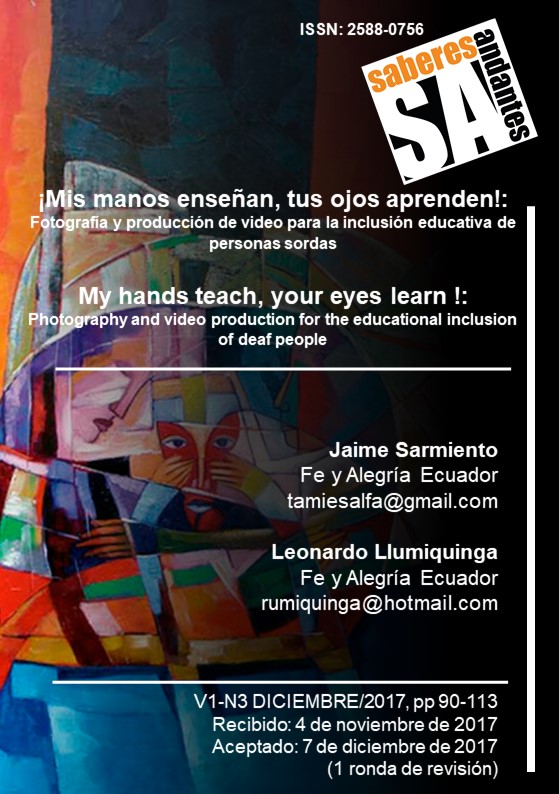My hands teach, your eyes learn!
Photography and video production for the educational inclusion of deaf people
DOI:
https://doi.org/10.53387/sa.v1i3.23Keywords:
education of deaf people, information and communication technologies, audiovisual production, training in photography, training in audiovisual production, linguistic rights and communication rightAbstract
This article approaches a sistematization of educational and communicational practice: "My hands teach, your eyes learn! the audiovisual communications magazine developed by a group of deaf students of the "Unidad de Educación Especial Fe y Alegría" in Santo Domingo, (Specialist Highschool) with the support of their teachers. This educational proposal started with a training program in photography and audiovisual production and ends as a result, with a visual educational magazine that demonstrates how listeners and deaf persons share and learn together, developing contents, beyond the language barriers. Additionally, the audiovisual magazine is integrated into the educational process of deaf young people and strength the skills far planning, teamwork, the use of ICTs and the promotion of the linguistic and educational rights of deaf people. Besides, it opens up deaf people world even further, reinforces their identity and prometes the use of sign language in education and in the production of educational material.
Downloads
References
Asamblea Nacional. (25 de Septiembre de 2012). Ley Orgánica de Discapacidades. Registro Oficial Nº 796. Quito, Ecuador: Registro Oficial.
Asociación Fe y Alegría Ecuador. (2013). La Educación Especial en Fe y Alegría Ecuador. Quito, Ecuador: Fe y Alegría.
Asociación Fe y Alegría Ecuador. (2014). Proyecto Mejora de la Calidad Educativa e Inclusión de estudiantes con discapacidad auditiva con la participación de familias, escuela y comunidad. Quito, Ecuador.
Asociación Fe y Alegría Ecuador. (2015). Guía para la Inclusión de Estudiantes Sordos en la Educación Regular. Quito, Ecuador.
Asociación Fe y Alegría Ecuador. (2016). Análisis de las fortalezas, retos y prácticas alineadas al Modelo Bilingüe Bicultural de 5 instituciones para estudiantes sordos. Informe de Análisis y Recolección de Información. Quito.
CONADIS. (2013). Agenda Nacional para la Igualdad en Discapacidades 2013-2017. Quito: Consejo Nacional de Igualdad de Discapacidades.
INEC. (2010). Población por condición de discapacidad, según provincia, cantón, parroquia y área de empadronamiento. Quito, Ecuador: Instituto Nacional de Estadísticas y Censos.
INEC. (2010). VII Censo de Población y VI de Vivienda. Quito: Instituto Nacional de Estadísticas y Censos.
Llumiquinga, L. (2014). Propuesta de Taller de Capacitación y Producción Audiovisual. Quito.
Llumiquinga, L. (2014). Tutorial de Producción Audiovisual. Quito.
Oviedo, A. (2010). La cultura sorda. Sexto Seminario Taller Modelo Educativo Bilingüe para niños sordos. México.
Parasnis, I. (1996). Cultural and Language Diversity and the Deaf Experience. Cambridge University Press.
Secretaría de Educación Pública. (2012). Orientaciones para la atención educativa de alumnos sordos que cursan la Educación Básica, desde el Modelo Educativo Bilingüe-Bicultural. México.
Unidad de Educación Especial Fe y Alegría. (2014). Registro de solicitud de cupos. Archivo general . Santo Domingo, Ecuador.

Downloads
Published
How to Cite
Issue
Section
License
Copyright (c) 2017 Saberes Andantes

This work is licensed under a Creative Commons Attribution-NonCommercial-ShareAlike 4.0 International License.
1. Derechos de autor
Las obras que se publican en Saberes Andantes están sujetas a los siguientes términos:
1.1. Saberes Andantes, conserva los derechos patrimoniales (copyright) de las obras publicadas, favorece y permite la reutilización de las mismas bajo la licencia Licencia Creative Commons 4.0 de Reconocimiento-NoComercial-CompartirIgual 4.0, por lo cual se pueden copiar, usar, difundir, transmitir y exponer públicamente, siempre que:
1.1.a. Se cite la autoría y fuente original de su publicación (revista, editorial, URL).
1.1.b. No se usen para fines comerciales u onerosos.
1.1.c. Se mencione la existencia y especificaciones de esta licencia de uso.








